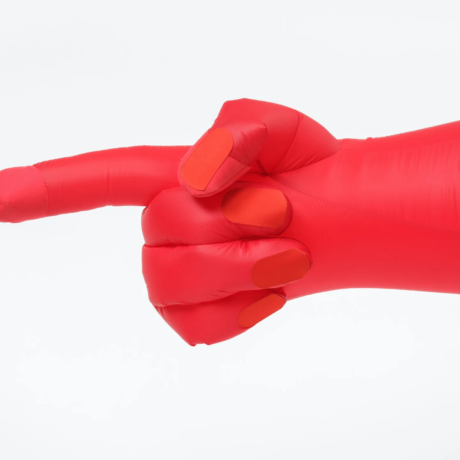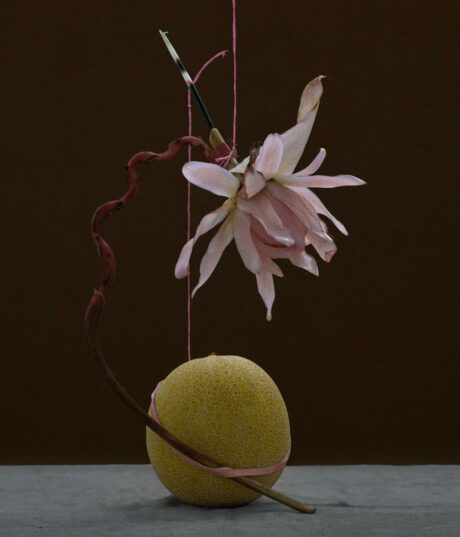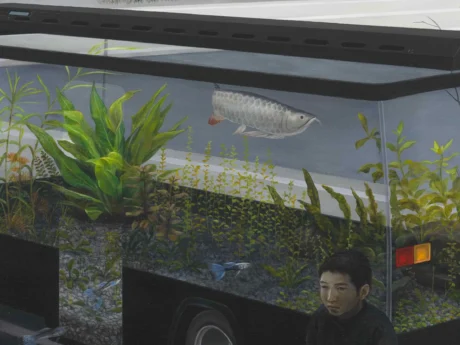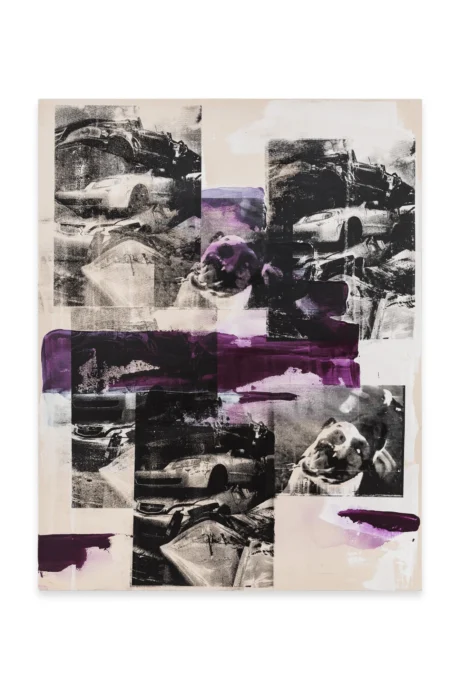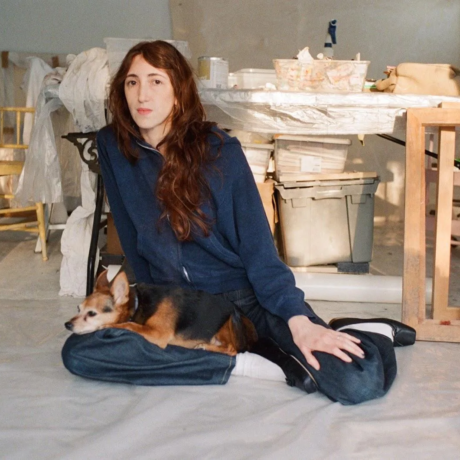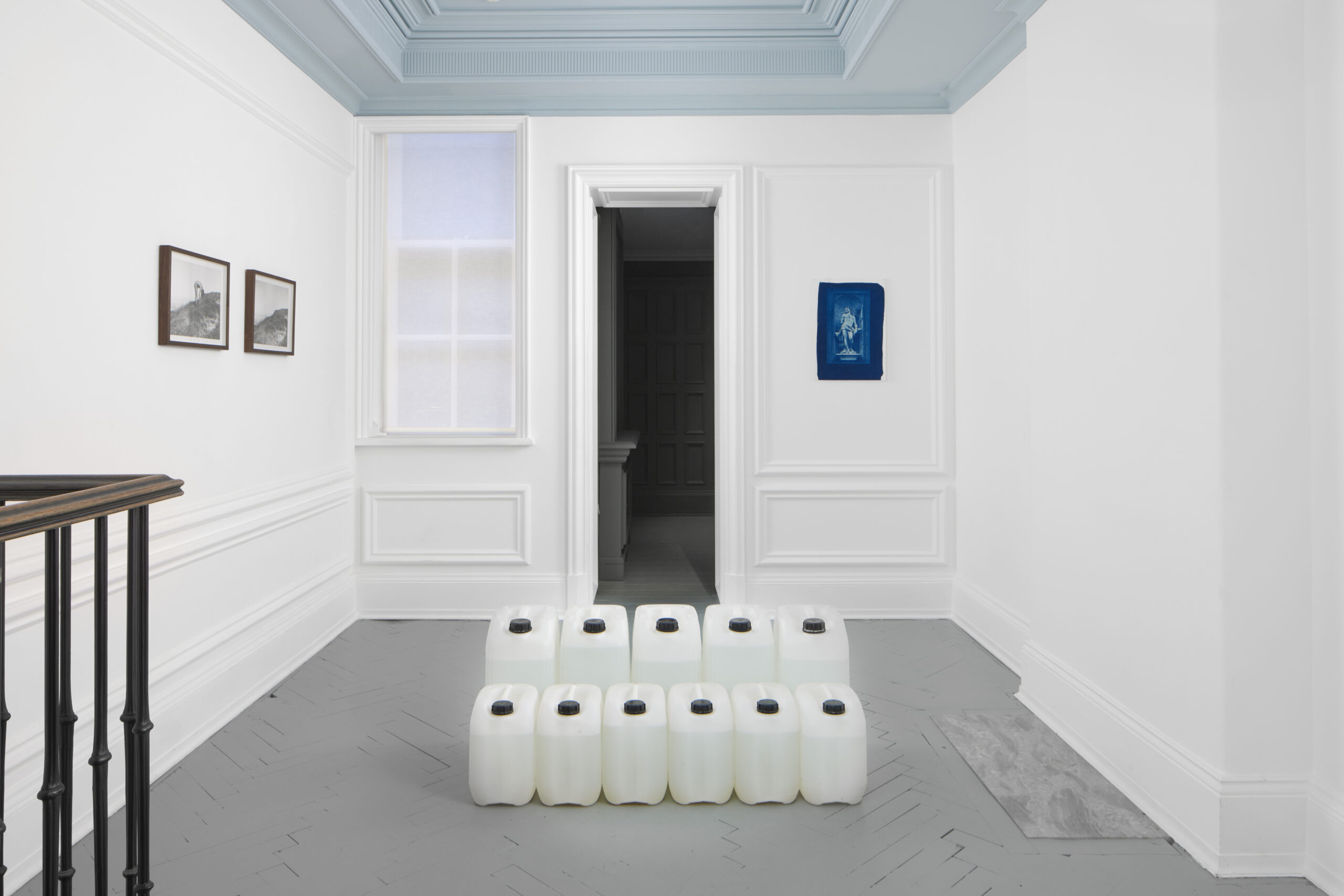
A small red ball is thrown against a white wall. One throw and the ball hits the ground, then the wall, then the hand of the thrower. Another throw and the ball repeats the same pattern. With each and every move, the ball, floor, wall and hand form a rough yet repetitive rhythm, a harsh sonic sequence, where the predictability of touch and the reverberating sound it creates are not always guaranteed. This asymmetrical circuit continues and the hand that triggers it remains in control, until the ball bounces one too many times against the floor. The circuit is tripped, the game thrown off course, the clanging sound of the ball revealing a breakdown.
This game of chance forms the basis of Rebecca Hancock’s Pass (2023), a video installation which is as much about forming auditory impressions as it is material ones. Known for her work involving repetition, mark-making and the situational position and presence of objects in a given space, Hancock’s Pass brings all such preoccupations to the fore in her ball-throwing experiment only to have them bounce back on us in a different guise. For though Pass is but one work in a group exhibition housing at least fourteen others, it is a piece that makes itself heard throughout the entire gallery. In its ludic regularity and force, the sound of Pass cannot be just that: passed over. Instead, the hit of the ball not only echoes against the wall and floor visible in Hancock’s video, but sharply reverberates around the walls, floors and works of Incubator, thereby shaping our impressions of the surrounding pieces as well as making a forceful impression on our own minds.

In its far-reaching audibility Pass encapsulates themes central to Five by Five, Incubator’s latest group show. In fact, Hancock’s piece inadvertently literalises the meaning of the exhibition’s title, which not only refers to the five established artists and their five chosen emerging artistic counterparts, but is in itself an old phrase taken from radio communications meaning ‘loud and clear’ (aptly, it is also a term used in basketball). Loudly and clearly then, Pass carries at the speed of sound themes of chance and agency, human collaboration and separation, ecological and socio-political crises, migration and home. To the beat of the bouncing ball, artists like Mona Hatoum and Tamara Al-Mashouk, Maggi Hambling and Jelly Green, Abigail Lane and Rebecca Hancock, Georgie Hopton and Alice McCabe, Ingrid Pollard and Matthew Arthur Williams, are brought together, their diverse works creating fruitful dialogues, the one artist impacting on the other.
As with the marks made by the ball in Pass, the photography of Matthew Arthur Williams and Ingrid Pollard documents the marks we make on the natural world. In his two black and white photographs, companion pieces parsing on issues of presence and absence, Williams captures a rural landscape with what appears to be a seascape in the background. In the first photograph, Assuming the Position III (2021), a naked woman stands bent over, her hands buried in the rugged turf and shrubs of the sloping landscape. Absorbed in the activity of connecting with the land, her body, though contrastingly stark against the dark granular depiction of grass, becomes one with the body of the landscape, if not a terrain unto itself. Yet in the subsequent work, Assuming the Position IV (2021), the woman is removed, her impression on the landscape and the viewer wiped clean. This vanishing, an erasure both in concept and form, challenges our relationship to the rural as well as our investment in pastoral representations. In his removal of the singularly human, the ceaseless sweep of this vast nonhuman vista comes into view and with it what we stand to lose: connection with the natural world as well as our place in it. Yet this erasure goes further to posit questions about looking, and the artistic and photographic developmental processes which facilitate this act. Like Hancock’s hand setting in motion the movement of the ball, Matthews’ removal of the human draws our attention to his handling of this view and the decisions involved in image-making overall. Thus Assuming the Position III and IV is as much about the marks we make on the landscape of the negative and paper as it is on the whole natural environment.
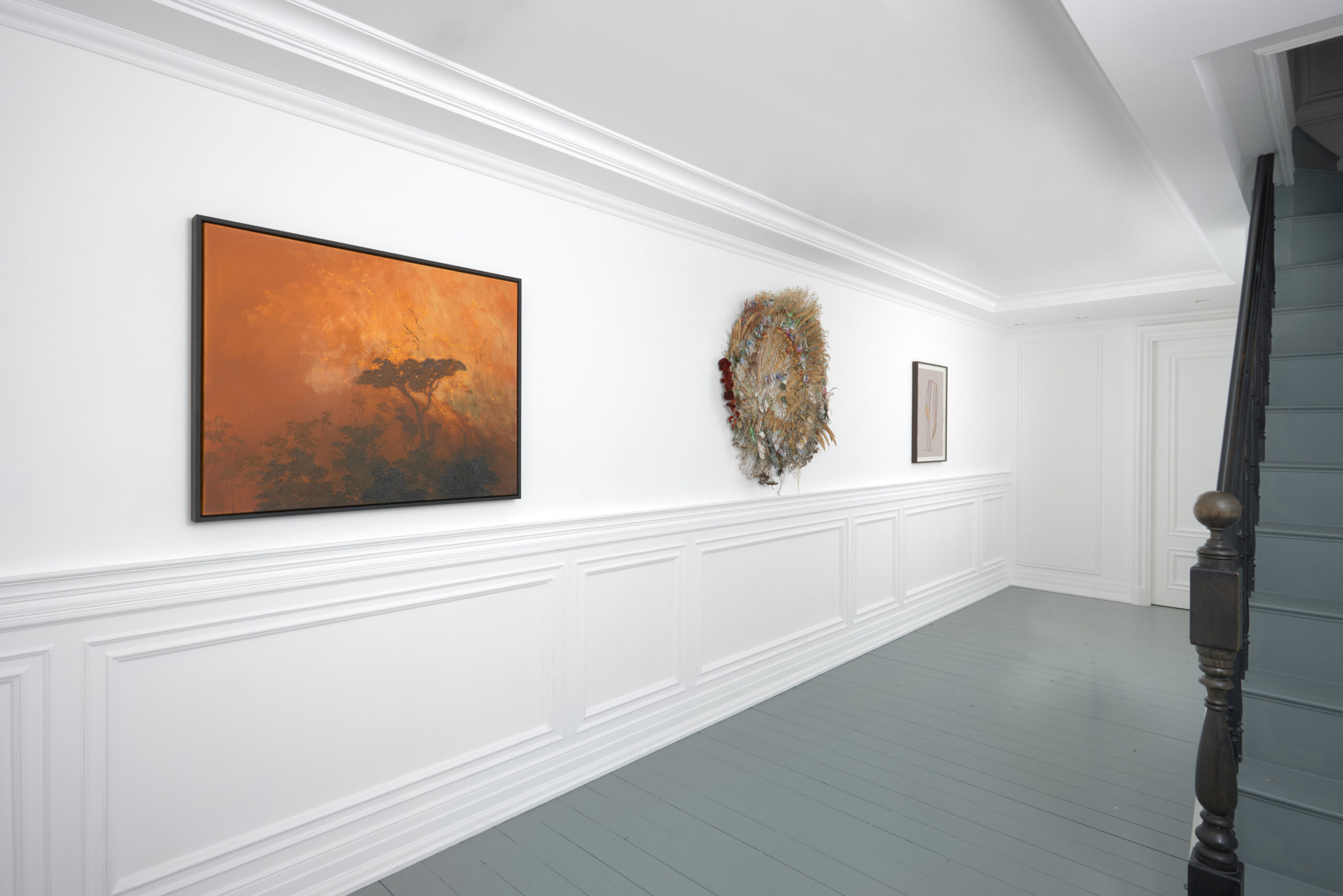
Historical decision-making and the inclusions and omissions this results in are also commented on by Ingrid Pollard. Cyanotypes printed on Fabriano paper, her works Rabbit Proof and Untitled (both 2014) interrogate romantic and classical conceptions of masculinity, race and what is deemed an artistic subject in and of itself. Unlike Matthews, whose monochromatic prospect drew us in through the retrieval and removal of a single figure, Pollard’s haunting blue prints demand us to consider what or who is the blueprint for art historical fascination and representation in the first place. Whilst Untitled depicts a classical male statue on a pedestal, Rabbit Proof shows a white bearded man embracing a large rabbit; Pollard juxtaposes a strange and rare moment of tenderness between man and beast with a cold impenetrable monument to art history. Between the two, we, again, question the decisions behind photographic image-making, the figures who are included versus those who aren’t, and those who have control over which marks remain visible and invisible.
Rendering the invisible visible is also important to Tamara Al-Mashouk’s sombre work, I’d search forever, I want to remember; Water Containers, (2023). Situated between Williams and Pollard’s photographs, with the severe score of Hancock’s video playing in the background, Al-Mashouk’s installation of eleven plastic jerry cans containing water from the English Channel unites the issues quietly reflected in the former artists’ works. Initially the presence of jerry cans causes visions of natural catastrophe, of current environmental crises where resources are scarce and people are pushed to ration the most basic yet essential life source: water. Yet upon further consideration, the rows of plastic containers bring the bodies of those lost to a surfeit of water – the strait of the Atlantic Ocean to be exact – to the surface of one’s mind. In 2023 over 29,000 people crossed the English Channel in an attempt to seek safety and refuge in Britain. Some would have been granted asylum – though left to suffer the hostilities of a post-Brexit, post-pandemic, anti-migrant Britain. Others, however, would have perished in the water before making it to shore, their bodies never to be recovered from the depths of the channel (five migrants have already died traversing it this year alone). Al-Mashouk’s startling work sees these bodies resurface, their forms recovered in liquid form, convicting us from within the ominous rows of the plastic containers. Sobering to behold, I’d search forever, I want to remember; Water Containers puts the erased and their lives back in the foreground again.
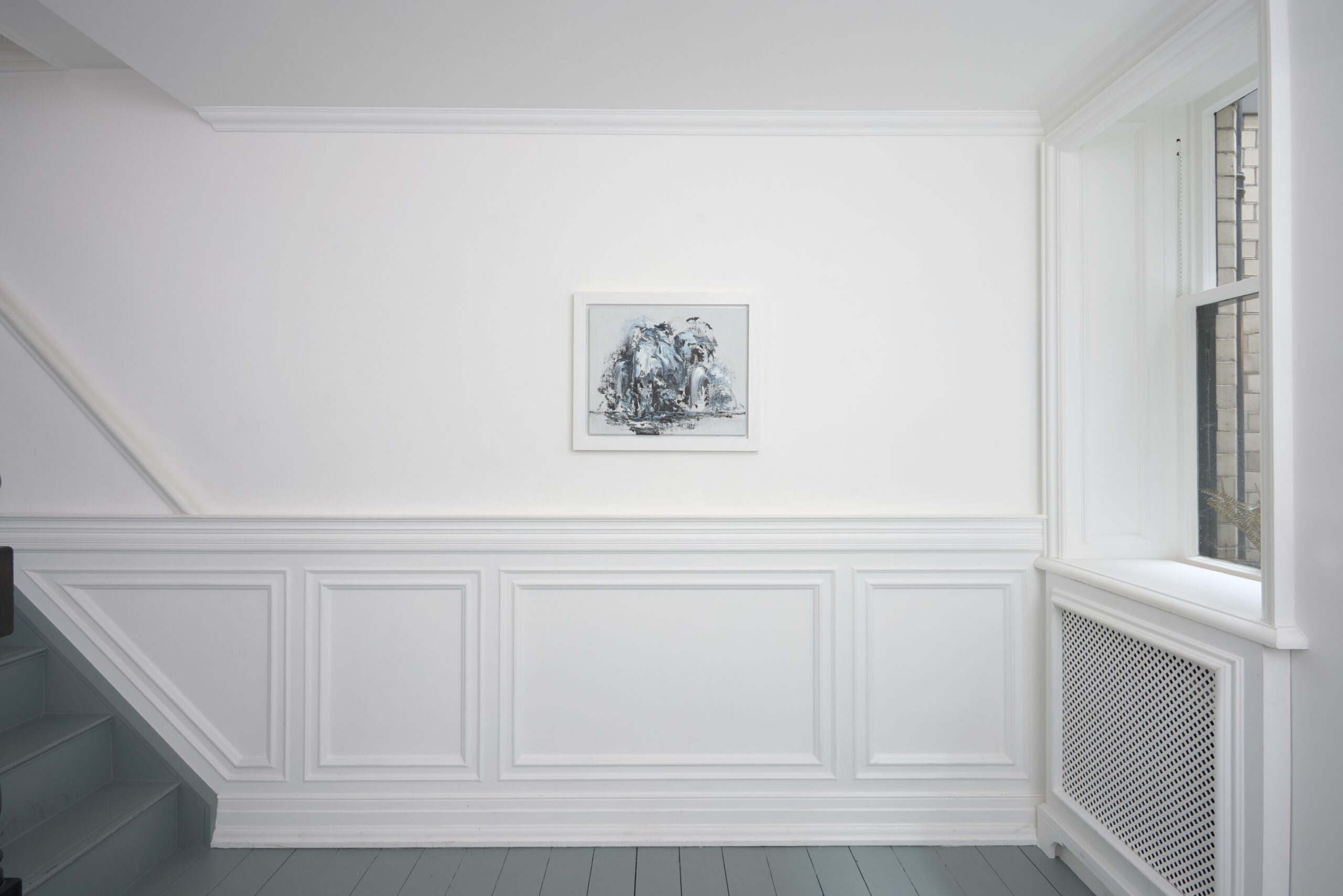
Likewise, Al-Mashouk’s established counterpart, Mona Hatoum, subtly refigures the precarity of migrant lives. Every Door a Wall (2003) consists of a voile curtain covered in a print featuring an image of migrants from a 1950s’ edition of The New York Tribune. Positioned between the gallery reception and its main space, visitors unwittingly pass through and touch the curtain without fully realising that they, too, have made a mark on an artwork as well as the metaphorical ‘door’ of the building. Highlighting the thresholds of the space and illuminating the physical impact of geopolitical and psychological borders, Every Door a Wall pushes us to think of the more violent demarcations migrants have strived and often failed to cross throughout history.
Yet migrations are not always directly owing to the forces of war and corruption. Many migrants, the victims of ‘environmental migration’, are forced to leave because of natural and ecological disasters (though this is no less down to the hands of man too). Two duos, Jelly Green and Maggie Hambling and Alice McCabe and Georgie Hopton, offer portraits of loss and hope when it comes to the current climate crisis facing us all. Jelly Green’s burnished arboreal scene, Burn at Dusk (2023), presents with quiet horror the destruction and deforestation caused by wildfire. In harmonious tones of amber, orange, ochres and blacks, Green offsets the sheer beauty of the colours and elegance of the brushwork with the actual carnage that is unfolding. But there is a cruelty to the juxtaposition of mentor and mentee. Across from Green’s painting, Hambling’s rendition of a cascade peers back. Each work is the equal opposite of the other, and yet both expressions of extreme devastation are implicated in the other’s own cause. Rising sea levels and flooding remain a constant concern, but the drought wrought by over-exposure to the sun, rising global temperatures and the wild fires that follow show that between Hambling’s watery image and Green’s flagrant one the ecological cause and effects are hard to distinguish. If Hambling’s characteristic bold and bolshie strokes of impasto-like paint dramatically unfold in Wall of Water XXII (2023), then Green’s delicate mark-making is equally sublime and shattering though quieter to behold. Each work is the solution to the slow violence of the other – dry needs wet and vice versa – but deliberately hung across from each other this remains unreachable, at least metaphorically.
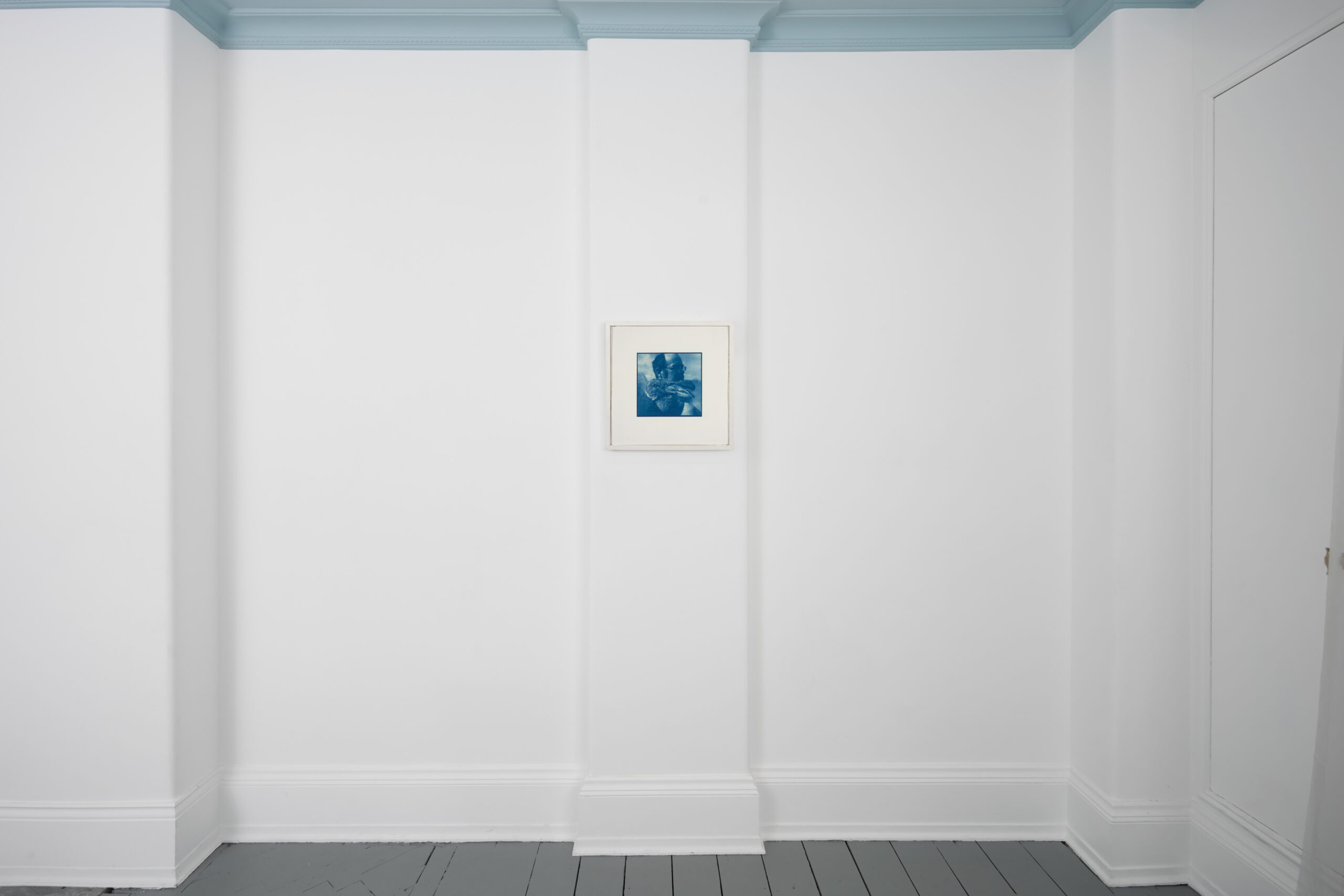
Hope, however, poetically steals in through the near-conversant and ecofeminist mixed media work of Alice McCabe and Georgie Hopton. Creating a kind of elemental symphony of their own – a silent one in answer to the abrasive sound of Hancock’s ball – McCabe and Hopton dream up works that simultaneously recycle natural elements – dried flowers, feathers, sticks and wool – and redefine what is “appropriate” media when creating art. Original matter, the stuff of fields, forests and meadows, shines joyously and playfully against hand painted backgrounds and wire mesh frames. Whilst McCabe’s Flipside Garden: Summer/Winter (2020) creates a flourishing collage of flora, one embroidered with paper images of plants and woven with dried flowers, Hopton’s Dream Catcher (ii) (2018) offers a poetic rumination on the small though no less precious occasions of beauty that nature affords us. A veritable garden of death and life working symbiotically, McCabe’s sculpture-cum-tapestry, like Hopkin’s carefully and thoughtfully arranged assemblage-cum-painting, looks to the human hands that cultivate and infers the human custodians who are supposed to cherish as well as be nourished by the earth.
This naturally brings us to Abigail Lane, whose fragile yet poignant embroideries of hands and a plaster sculpture of feet remind us of Hancock’s mark-making game upstairs on the ground floor. At the far end of the gallery, Making Tracks (2023) could easily be missed and yet this sensitive embroidery of red threads encompasses all of the aforementioned works. There is the disembodied offering of human presence and absence as seen in Al-Mashouk and Hatoum’s object-oriented installations, as well as Williams’ rural sights and Pollard’s cyanotypes. And there is the chaos or harmony human hands can wreak on the natural and social worlds evidenced in Green and Hambling’s paintings and the works of McCabe and Hopton. Yet Lane’s transparent hands, though thin outlines of disintegrating red thread, impart a possibility for new interaction, signal new convergences, new mark-making and new methodologies of creating, and reach out towards new collaborations, across generations, nationalities and cultures – as this show does – to offer us hope for the future of art, but best of all the impact, much like the thrown ball, on each other and the world around us.
Written by Hannah Hutchings-Georgiou
